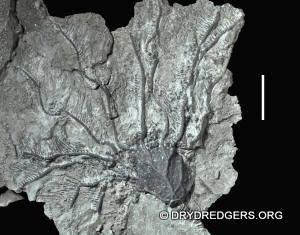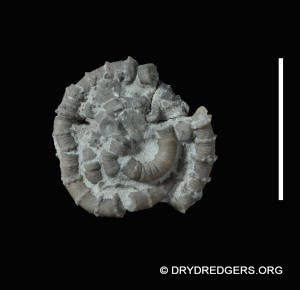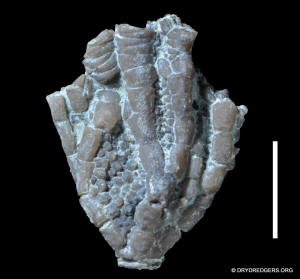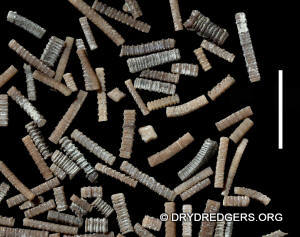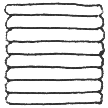A Beginners Guide To Identifying
Cincinnatian Crinoids
By Jack Kallmeyer
Camerata - Monobathrida
Canistrocrinus typus
Compsocrinus harrisi
Glyptocrinus decadactylus
Glyptocrinus fornshelli
Glyptocrinus nodosus
<=== New Species
Pycnocrinus dyeri
Pycnocrinus subglobosus
Xenocrinus baeri
Crinoid Anatomical
Glossary
Return to Crinoid main page
Canistrocrinus typus
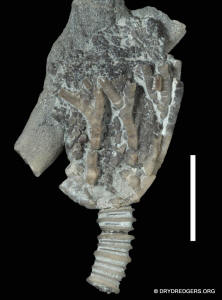 
10 mm scale, back and front.
Photos by Jack Kallmeyer |
Canistrocrinus has prominently raised
rays
and anal series on the calyx. The plates between the rays are large
compared to those in Xenocrinus. The five
rays of the cup branch to
produce four free arms per ray. The arms are
pinnulate.
Canistrocrinus is found in the Waynesville and Liberty
Formations. |
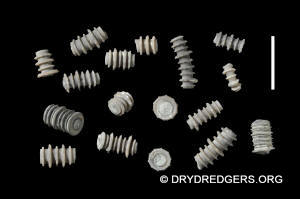
10 mm scale
Photo by Jack Kallmeyer |
The stem
of Canistrocrinus is round in cross-section
with alternating large diameter nodals and smaller diameter
internodals.
Mid-stem nodals have radial nodes projecting from them. |
Pycnocrinus dyeri
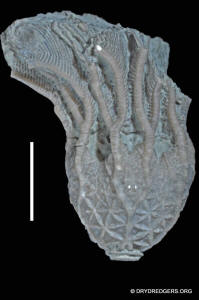 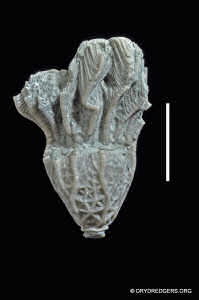 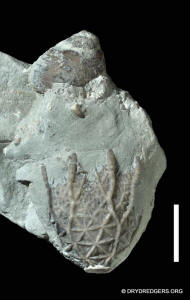
10 mm scale
Photos by Jack Kallmeyer
|
The somewhat globular cup of this species is ornamented with
stellate ridges making it look superficially like
Glyptocrinus decadactylus. Originally described as
Glyptocrinus dyeri, it was moved in to the genus
Pycnocrinus by Bassler & Moodey in 1943 based
upon cup morphology. The most obvious difference between
Pycnocrinus and Glyptocrinus is
the location of ray branching – the five prominent rays branch only once
on the calyx in Pycnocrinus but they branch
twice on the calyx in Glyptocrinus. The arms
are heavily pinnulate.
This crinoid is
found in the Maysvillian Stage and lower Richmondian Stage.
 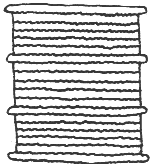
Columns are round in cross-section with large diameter
nodals
alternating with multiple smaller diameter
internodals. |
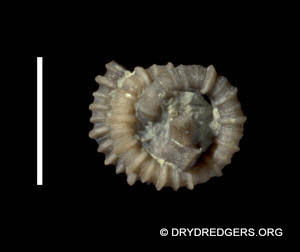
10 mm scale
Pychnocrinus
distal coil
holdfast
Photo by Jack Kallmeyer |

Attachment of the relatively short (up to about 20 cm) column is by
coiling of the distal stem around another object. |
Pycnocrinus subglobosus
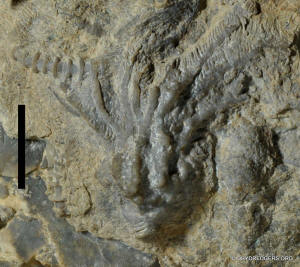 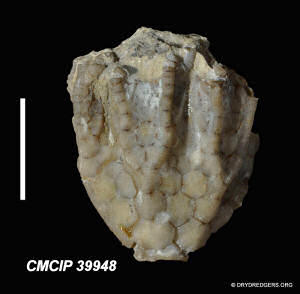
10mm scale
(#1) Probable juvenile
Pycnocrinus subglobosus
(#2)
Cincinnati Museum Center CMCIP 39948
with permission of Brenda Hunda
Photos Jack Kallmeyer
|
The morphology of Pycnocrinus subglobosus
is as with other members of this genus (see
P. dyeri
for more detail). The only exception is that the
calyx plates are smooth
and without ornamentation.
This crinoid was found in the
Corryville Formation |
Glyptocrinus decadactylus
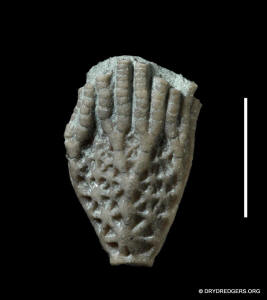 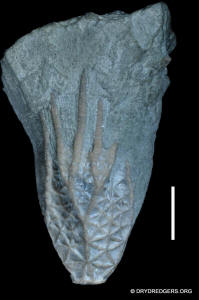
10 mm scale
Photos and artwork by Jack Kallmeyer |
The cup of this species is ornamented with stellate ridges making it
look like Pycnocrinus dyeri (see the
P. dyeri description for details of the differences).
 
Columns are round in cross-section with large diameter
nodals
alternating with multiple smaller diameter
internodals.

Attachment of
the relatively short (up to about 20 cm)
column is by coiling of the
distal stem around another object.
This species is found in the
Fairmount Member of the Fairview Formation.
|
Glyptocrinus fornshelli

10mm scale
Miami University MUGM 28121
With permission of Kendall Hauer
Photo Jack Kallmeyer
|
The cup plates of this species are very thin with distinctive
ornamentation comprised of fine ridges and small nodes. The Richmondian
Glyptocrinus fornshelli is one of the largest
crinoids in the Cincinnatian with cup heights around 75 mm, not
including the arms. The heavily pinnulate
arms themselves branch three times above the cup making for what had to
be a very impressive and bushy crinoid. The large size coupled with the
thin cup plates makes preservation of complete specimens rare. Most are
found as masses of disarticulated arms and cups.
This species appears in the
Waynesville and Liberty Formations. |
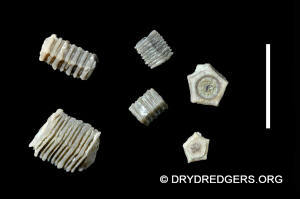
The stem of G. fornshelli
is comprised of very thin columnals
that are sharply pentagonal in outline.
10 mm scale
Photo by Jack Kallmeyer
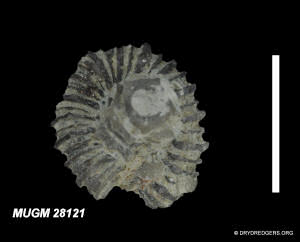
The holdfast of G. fornshelli is of
the distally coiled stem variety.
10 mm scale
Miami University MUGM 28121
With permission of Kendall Hauer
Photo by Jack Kallmeyer
|
|
Compsocrinus harrisi

10 mm scale
Courtesy of Steve Brown
Photo by Jack Kallmeyer
|
Compsocrinus harrisi is roughly similar to
Glyptocrinus in ray branching in that they
divide twice on the cup producing four free arms per ray. The arms do
not branch above the cup. Unlike Glyptocrinus,
the basal plates do not all touch each other - the primanal plate
separates the basal plate series. The anal series of plates proceeds up
the side of the cup as a raised ridge.
The Treatise on Invertebrate Paleontology
indicates that the column can be quadrangular or round. A portion of a
round column is visible on the specimen pictured. Holdfast type is
presumably a distal coil although that cannot be determined from the
material currently available.
Compsocrinus
is known from the Waynesville Formation although the specimen pictured
here was collected in the Liberty Formation.
The specimen
illustrated was provided by Steve Brown for inclusion on this webpage. |
Crinoid
Anatomical Glossary
The Dry Dredgers and individual contributors reserve the
rights to all information, images, and content presented here. Permission to
reproduce in any fashion, must be requested in writing to admin@drydredgers.org.
www.drydredgers.org is designed and maintained by Bill Heimbrock.

















